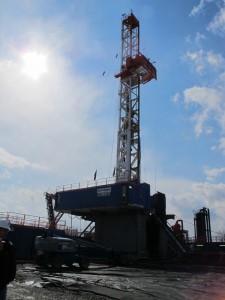Some Question Study that Finds Pa. Shale Drillers Polluting Less
Last week the Shale Resources and Society Institute at the State University of New York at Buffalo released a report on the environmental impacts of natural gas drilling in Pennsylvania. The researchers used violation data from the Department of Environmental Protection to conclude that state regulation has reduced the number of damaging environmental incidents at gas drilling sites from 2008 to 2011.
“Significantly, the incidence of polluting environmental events declined 60 percent between 2008 and August 2011, from 52.9 percent of all wells drilled in 2008 to 20.8 percent through August 2011 (Figure ES2). On this basis, the Marcellus industry has cut its incidence of environmental violations by more than half in three years, a rather notable indicator of improvement by the industry and oversight by the regulators.”
The study is, in part, meant to inform New York regulators on how to reduce environmental impacts once that state’s current moratorium is lifted and drilling begins.
“In conclusion, this study demonstrates that the odds of non-major environmental events and the much smaller odds of major environmental events are being reduced even further by enhanced regulation and improved industry practice. Moreover, the environmental impacts of most of these events have been almost completely mitigated by remedial actions taken by the companies.”
The report, titled “Environmental Impacts of Shale Gas Drilling: Causes, Impacts and Remedies,” says that although the number of wells increased over those three years, per well violations issued against drilling companies declined. The study’s authors, Timothy Considine, Robert Watson, and John Martin all have ties to industry. But the report was funded by SUNY Buffalo, not by industry sources.
As part of the study’s analysis, the authors divided the violations between what the DEP labels “environmental, health and safety” and “administrative.”
“A notice of environmental violation often does not indicate an actual environmental event because many of these citations are for administrative violations or are issued to prevent pollution from occurring.”
The report provides a detailed explanation of environmental violations, and calculates that they make up just about 38 percent of the total number of violations.
To look at a list of how the state distinguishes between environmental and administrative violations, click on our Shale App here. What you’ll find are 65 violations issued by the DEP since 2009 for “improperly lined pit,” and 38 citations for “improper casing to protect fresh groundwater.” Both are labeled “administrative.” The largest number of administrative citations (235) fall into the catchall category of “used only when a specific O&G Act code cannot be used.” When looking at DEP data, it’s difficult to know what those violations mean, and if they involved anything other than faulty paperwork.
Fractracker.org took up this issue last February with an analysis of the DEP’s administrative violations.
“The two most frequent administrative violations cited are so vague that they are practically meaningless for our purposes. With many of the rest of the categories, it is possible to argue that they are fundamentally administrative or fundamentally environmental, health and safety in nature.”
Fractracker.org concludes that out of 2,364 administrative violations since 2005, 696 separate violations labeled as “administrative” should actually be “environmental, safety and health,” according to DEP’s descriptions.
The authors of the SUNY Buffalo report originally issued a release saying the study was peer-reviewed, but later retracted that statement. Somone who did review the study, Scott Anderson on the Environmental Defense Fund, states on his website that he doesn’t agree with all of the report’s conclusions. He praises much of the report for doing the necessary work of crunching data on regulatory enforcement. But Anderson says some of the assumptions are “questionable,” including:
“…the idea that a violation isn’t an “environmental” concern if it is a violation of “paperwork” or “preventative” regulations and didn’t result in immediate, actual harm to the environment.”
The left-leaning Public Accountability Initiative took a fine-tooth comb to the report and issued its own response.
“Taken together, the serious flaws in the report, industry-friendly spin, strong industry ties, and fundraising plans raise serious questions about the Shale Resources and Society Institute’s independence and the University at Buffalo’s decision to lend its independent, academic authority to the Institute’s work.”

















